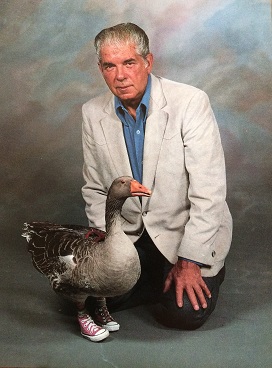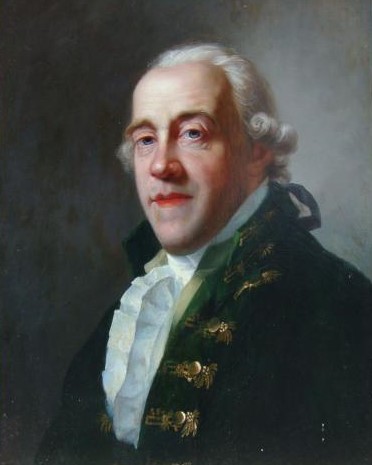From an April Fools’ feature in LIFE, April 4, 1938:

The photo appeared in a German paper, which claimed the story was American. “To Germans, actual American goings-on are fantastic enough to be April Fools’ tricks.”
From an April Fools’ feature in LIFE, April 4, 1938:

The photo appeared in a German paper, which claimed the story was American. “To Germans, actual American goings-on are fantastic enough to be April Fools’ tricks.”

When a goose without feet was hatched in Harvard, Nebraska, in 1987, local inventor Gene Fleming adopted the bird, fitted him with baby-sized shoes, and taught him to walk. In time “Andy” learned to swim and fly as well; he gave inspiration to disabled children and received a lifetime supply of shoes from Nike, but it wasn’t to last — in 1991 he was killed by an unnamed perpetrator.
From reader Éric Angelini: During a standard chess game, after Black’s fifth move we notice that three rooks have been captured on the same dark square. Which square is it?
If mercy modifies the demands of justice, then to be merciful is perhaps to be unjust. But manifesting injustice is a vice, not a virtue. This seems to mean that mercy is a vice. A sentencing judge has been hired to enforce the rule of law that society has agreed upon. If he tempers this, even through love or compassion, then arguably he’s departing from his sworn obligation. Angelo says in Measure for Measure:
I show [pity] most of all when I show justice,
For then I pity those I do not know,
Which a dismissed offense would after gall,
And do him right that, answering one foul wrong,
Lives not to act another.
(If we try to claim that mercy is a form of justice, so that every act of mercy is just, then we’re saying that one has a right to mercy, that it’s not a gift. That seems wrong too.)
(Jeffrie G. Murphy and Jean Hampton, Forgiveness and Mercy, 1988, via George W. Rainbolt, “Mercy: An Independent, Imperfect Virtue,” American Philosophical Quarterly 27:2 [April 1990], 169-173.)
A conference is attended by 1,000 delegates from various countries. It’s known that any three delegates can speak together without help, though one of the three may have to serve as interpreter for the other two. Prove that all the attendees can be accommodated in double rooms so that the two occupants of each room can speak to each other.

The beginnings of Algebra I found far more difficult [than Euclid], perhaps as a result of bad teaching. I was made to learn by heart: ‘The square of the sum of two numbers is equal to the sum of their squares increased by twice their product.’ I had not the vaguest idea what this meant, and when I could not remember the words, my tutor threw the book at my head, which did not stimulate my intellect in any way.
In the beginning there was Aristotle,
And objects at rest tended to remain at rest,
And objects in motion tended to come to rest,
And soon everything was at rest,
And God saw that it was boring.
Then God created Newton,
And objects at rest tended to remain at rest,
But objects in motion tended to remain in motion,
And energy was conserved and momentum was conserved and matter was conserved,
And God saw that it was conservative.
Then God created Einstein,
And everything was relative,
And fast things became short,
And straight things became curved,
And the universe was filled with inertial frames,
And God saw that it was relatively general, but some of it was especially relative.
Then God created Bohr,
And there was the principle,
And the principle was quantum,
And all things were quantified,
But some things were still relative,
And God saw that it was confusing.
Then God was going to create Furgeson,
And Furgeson would have unified,
And he would have fielded a theory,
And all would have been one,
But it was the seventh day,
And God rested,
And objects at rest tend to remain at rest.
— Tim Joseph

“Everyone believes in the normal law, the experimenters because they imagine that it is a mathematical theorem, and the mathematicians because they think it is an experimental fact.” — Gabriel Lippmann, in a letter to Henri Poincaré
(Thanks, Tom.)

“A portrait is a painting with something wrong with the mouth.” — John Singer Sargent

Subtitled “A Novel in Woodcuts,” Lynd Ward’s 1929 parable Gods’ Man unfolds in images, making it an important forebear of the modern graphic novel. A young artist makes his way to the big city, where a masked stranger gives him a magic paintbrush. The adventures that follow remark on the roles of love and commerce in an artist’s life; in the end the stranger returns to claim a reward.
Despite its unusual format, Ward’s book sold more than 20,000 copies during the Depression, and he followed it up with five more wordless novels. When he died in 1985, he was at work on an ambitious seventh, which Rutgers published in 2001.